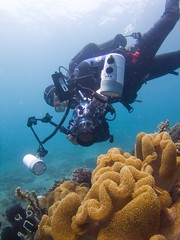I’ll re-print them here monthly in my blog, with a little more room for explanations and photos.
Your Experience Level and Guarding Against Task-Loading
Before we "dive" in, lets do a quick review of dive skills and experience necessary for your safety and the protection of the natural environment that you want to photograph. You need to have excellent buoyancy skills with intuitive, well-practiced, abilities as a diver to get into dive photography. I feel that it takes most new divers between 50-100 cold-water dives, because you will be adding a lot of task-loading and additional skills.
Not having this experience can result in damaging a reef, or more dangerously, an unsafe situation for you. You should feel that diving is intuitive to you and not have to think about it too much.
That doesn't mean that you can't buy your camera and become just as intuitive with your camera skills while you gain diving experience. It's a little tough to read a manual when you're 60 feet under water, so knowing your camera well really helps.
A hidden danger to a dive photographer, particularly in cold-water, is task loading beyond your experience level, or what the diving conditions can dictate. If in doubt, leave the camera topside, explore and shoot another time. Dive safety and protection of the underwater environment must come first!
Getting Started
Diver-photographers are faced with a bewildering assortment of cameras and options when it comes to buying a camera. Digital camera technology seems to change every day. Rather than just buying something that looks cool, or that a salesman recommends, I’d suggest a more methodical approach.
- What do you want to do with your photos?
Use them on a website or in emails? Print snapshots, or large wall-prints? Maybe see your work published? - How much do you want to grow your system? Are you starting out with a digicam and thinking about growing into a DSLR system later, or is your use more casual, capturing a few shots from a dive trip for fun?
- Where are you going to be shooting? Tropical or cold water? Working controls with gloves on, strong strobes and having durable equipment is important here in the Pacific Northwest. In tropical waters a lighter, smaller system may work fine for you and be easier to pack and carry.
- What do you like to shoot?Macro? Fish-portraits, maybe a close up of your buddy? Or do you want to “shoot up the reef” and do wide-angle shots?
- Do you want a camera for above-water, as well as underwater, use? How well supported is it, can it take good top-side photos as well?
- How much are you planning on upgrading in the near future?What strobes will it connect to? External lenses and other add-ons? Can they be used with other cameras and systems?
And, oh yeah, how much are you able to spend? This is not a cheap hobby, and you pretty much get what you pay for.
My Recommendations
I generally recommend a camera and housing as opposed to an amphibious camera, or dedicated camera/housing solution. Canon, Olympus, Fuji and Nikon build an amazing amount of cameras and many can be used very successfully underwater in a housing. The competition between these companies means that their feature-sets and technical advances are changing much faster than dedicated underwater cameras. Plus, there are more housings, external equipment and third-party solutions available, that can be moved to an upgraded system later. Simply put, they are a better value and can be used well above water too.
There are some very good, dedicated amphibious cameras; some have good controls and a sharp lens. They are smaller to carry and simpler to use, but you'll be at the higher price range to get the control and quality you want. I think housed systems offer more quality for less money.
My company Optical Ocean Sales.com, is an authorized dealer for Fantasea Line underwater photography products, which makes housings for Nikon CoolPix digicams and DSLR housings for Nikon, Canon and Olympus. I really like the CoolPix P3 and the Nikon D80 or Canon xTi 400 for underwater use.
Make sure whatever camera you buy, that you have as much manual control as possible. Why? Because most automatic camera features are not designed for the low light conditions you find underwater. Also with an external strobe, you’ll need to use manual or aperture/shutter priority modes to adjust your strobe exposure.
Whatever camera you have, my best advice is to get out there and shoot! Practice does make perfect!
Next Column: 5 Tips for Better UW photos

